General Immigration Information
Learn more about visas, immigration best-practices, and other helpful information!
Understanding Working Without Authorization
Understanding Working Without Authorization
The main goal of this article is to give you information about the risks and consequences of working in the United States without proper authorization. We will also explain some potential options for people in the United States working without authorization.
Working in the United States without proper authorization is generally not allowed, and people who are working without authorization or overstaying their visas may face serious consequences. However, some family members of US citizens seeking a green card through marriage may have certain exceptions or options. Please note that this article is not a substitute for legal advice. There are possible repercussions if you work in the United States without proper authorization. It is a good idea to talk to an immigration attorney or other qualified immigration professional to learn more about your options and the risks and consequences of your situation.
Authorization within the Context of USCIS Immigration
If you are planning to work in the United States, it’s essential to understand the concept of work authorization. Work authorization refers to the legal permit required for foreign nationals or non-citizens to work in the United States. Different types of visas offer different levels of employment authorization, so it’s essential to understand what kind of work you are allowed to do based on your visa type.
Authorized work is any work done with current, valid work authorization. Unauthorized work is any work done when someone does not have current, valid work authorization or work outside the scope of their work authorization. The US government grants work authorization through various visa programs, such as the H-1B program for skilled workers and the E-2 program for investors. If you are interested in working in the United States, it may be worth exploring these options to see if you are eligible.
For example, an F-1 visa and a J-1 visa are two types of visas that allow foreign nationals to come to the United States temporarily. They have different purposes and restrictions, though.
Take the time to learn about your specific work authorization and its privileges and restrictions.
Accepting Unlawful Employment while in the US
Accepting unlawful employment violates US immigration laws and can have severe consequences, including being barred from applying for a green card or permanent resident status. If someone is considering accepting unlawful employment in the United States, they can consult with an immigration attorney or other qualified immigration professional. They can help you understand the potential risks and consequences of this action and advise you on any possible options that may be available to you.
There are certain situations where USCIS may grant forgiveness for unauthorized employment. For example, the Violence Against Against Women Act (VAWA) protects specific individuals who have experienced abuse or violence at the hands of a US citizen, permanent resident spouse, or parent. Additionally, certain military service members and their families may be eligible for forgiveness for unauthorized employment.
If you are in the United States on a visa and have overstayed your visa, or if you have worked without authorization, you may be able to adjust your status to a lawful permanent resident (also known as getting a green card). However, this is not the case for all immigrants, as the eligibility to be forgiven for unauthorized work only applies to immediate family members of US citizens seeking a green card through marriage.
View the screenshot below for more information about these exceptions to the adjustment bars. Please click here to read more on the USCIS website.
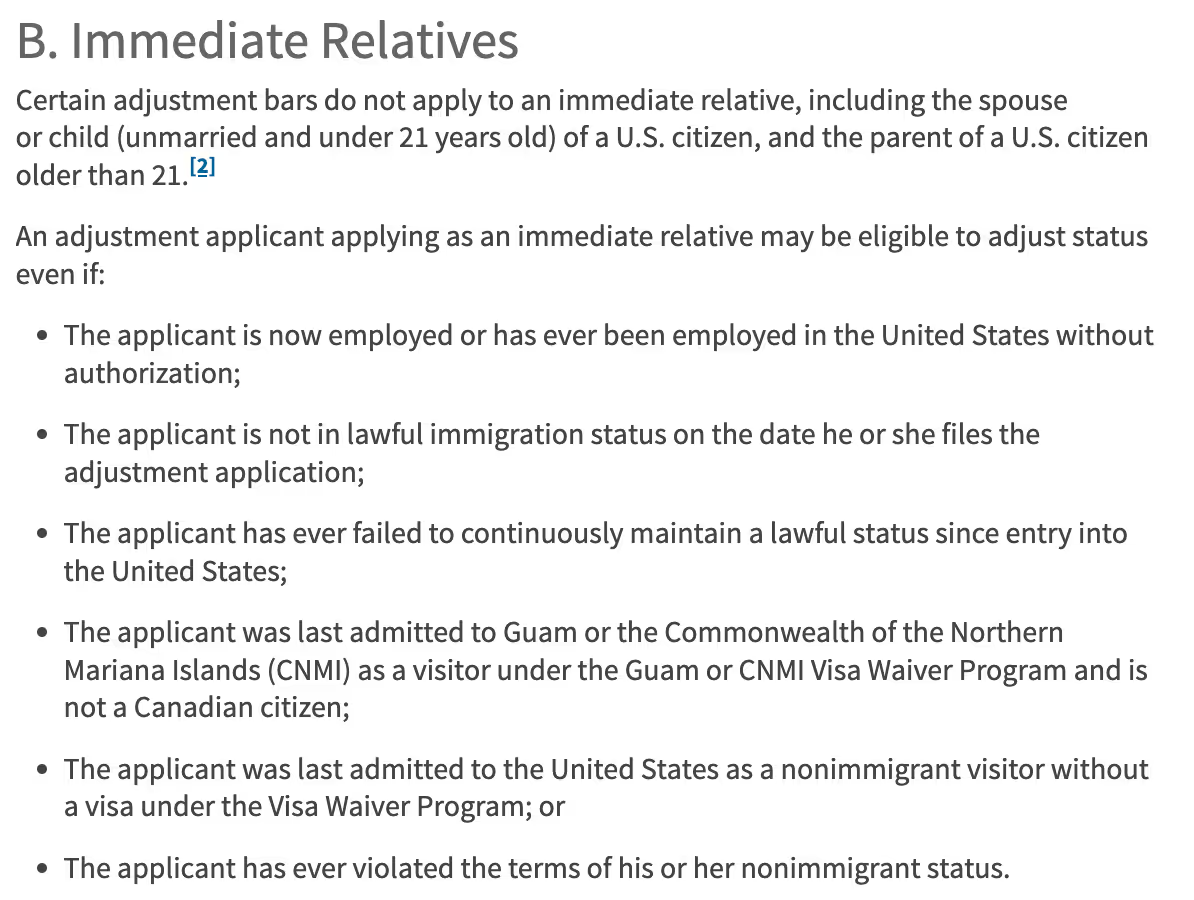
Working Without Authorization
It is not legal to work in the United States without proper authorization. If you are in the United States on a nonimmigrant visa, such as a tourist visa, you are not allowed to work while you are in the country. If you are found to be working without authorization, you could face serious consequences, including deportation.
It is also important to note that specific programs may allow you to work in the United States legally, such as the H-1B visa program for skilled workers and the E-2 visa program for investors. If you are interested in working in the United States, it may be worth exploring these options to see if you are eligible.
If you are considering applying for a green card and have worked without authorization, keep in mind that failing to disclose this information or providing false information on your application can have severe consequences and may result in USCIS denying your application or your deportation.
It is also important to note that falsely claiming US citizenship or permanent residency to work is a severe violation of immigration laws and can have serious consequences. Suppose you have used false documents or made false claims to work. In that case, it is strongly advised that you consult with an immigration attorney or other qualified immigration professional as soon as possible. They can help you understand the potential risks and consequences of these actions and advise you on any potential options available.
Overall, it is vital to understand the legal requirements for employment in the United States and to follow the proper procedures to ensure that you can work legally. As previously discussed, some of these requirements can be visa-specific, meaning that you should ensure that you are familiar with the roles of your specific visa type.
SimpleCitizen can assist you and offer you peace of mind in adjusting your status or applying for a green card. Find out more here.
Traveling on a Dual-Intent Visa
Wondering if you can travel with a dual-intent visa while your green card application is still pending
Wondering if you can travel outside the US using a dual-intent visa while your green card application is pending? Here, we will outline the options, regulations, and potential risks for traveling when you have a dual-intent visa. This article will review traveling and reentering the US on a dual-intent visa, which visa types allow for reentry into the US while a green card application is pending, and applying for Advance Parole while on these visa types.
For information on traveling abroad while on other nonimmigrant visa types, please click here.
Non-Immigrant Visa and Immigrant intent
To receive approval for a non-immigrant visa (such as B-2, F-1, J-1, etc.), a visa applicant must prove to the consular officers at the US Embassy or Consulate that they only plan to stay in the US temporarily on that visa. In addition, they must show that they do not have any plans to stay in the US and become a permanent resident. They must prove that their reasons for applying for that visa match the defined purpose of that visa, such as visiting for no more than 60 days, studying to complete a degree, or completing a 1-year Au Pair program.
Immigrant visas, such as K-1, CR1, and IR1, allow the applicant to immigrate to the US. With these visas, the applicant does not have to have any plans to depart the US once they arrive. They will need to prove to the consular officers that they intend to move to the US permanently.
What is a “dual-intent” visa?
Dual-intent visas, such as H-1B, K-1, and L, allow for both immigrant and nonimmigrant intent when entering the US. Someone who enters the US on a dual-intent visa for a temporary stay is less likely to be scrutinized if they also plan to immigrate to the US.
Though they have dual intent, K-1 visas only offer a single entry into the US - once a K-1 visa has been used to enter the US, it cannot be used to travel outside the US and reenter again on the same K-1 visa.
Please note that the O-1 visa is also considered to be a dual-intent visa; however, the travel restrictions for O-1 are a bit different from H-1B, K-1, and L visas. Please continue reading for more information about O-1 travel information.
Can I travel outside the US after I submit my green card application?
Someone on a nonimmigrant visa cannot travel and reenter the US while their green card application is pending without approved travel authorization (Advance Parole). However, in many cases, someone who is on a dual-intent visa can travel and reenter the US on that visa. They do not need Advance Parole to return to the US after a brief trip (less than 6 months).
Please note, however, that someone who does not have a valid, unexpired visa stamp in their passport for their dual-intent visa must apply and be approved for that visa at a US Embassy or Consulate abroad before being authorized to reenter the US.
Why do I need a Visa Stamp?
Once someone has applied for a dual-intent visa type like H-1B while inside the US through the “change of status” process, they will receive an I-797 Approval Notice from USCIS once their change of status is approved.
The I-797 Approval Notice will show that their H-1B status has been approved and that they are authorized to work for the employer who sponsored that visa. However, if they travel with this document alone, they may find themselves stuck outside the US when Customs and Border Protection (CBP) inspects them at the airport. CBP does not accept I-797 Approval Notices for reentry into the US. For this reason, the dual-intent visa holder must obtain a visa stamp at the US Embassy or Consulate abroad to return to the US on a dual-intent visa.
It is essential to plan if you do not have a dual-intent visa stamp on your passport. If you plan to take a short, week-long trip abroad, you may not have enough time to receive your visa stamp before returning. Remember that many US embassies/consulates have ‘busy’ seasons around holidays, so securing your appointment before travel can help you save time.
For example, if someone in the US applied for a Change of Status from the F-1 visa to H-1B and their Change of Status was approved, they would not have an H-1B visa stamp in their passport. An I-797 Approval Notice from USCIS is insufficient for reentry into the US.
Likewise, if someone has an expired H-1B visa stamp in their passport but extended their H-1B while in the US, they would also need to apply for a new visa stamp to reenter the US on H-1B while their green card application is pending.
Please remember that each entry into the US is at the discretion of the CBP officer who inspects you at the border - there is never a guarantee that you will be allowed entry. However, the risk of being denied entry is low if you have the proper documentation (e.g., your valid, unexpired passport and unexpired H1B visa stamp).
Should I apply for Advance Parole if I have a dual-intent visa?
If someone is on a dual-intent visa, like H-1B, and they submit Form I-131 for Advance Parole with their green card application, they would be able to use that travel authorization once approved. Doing so can be helpful in situations where their H-1B expires or they fall out of status on that visa. There are some things to be aware of for those in the United States dual-intent visas when they apply for Advance Parole:
- If someone travels and re-enters the US on their dual-intent visa while their Form I-131 is still pending, their Form I-131 is likely to be denied for abandonment.
- If someone plans to maintain their dual-intent visa status, but travels and re-enters the US on their Advance Parole instead of their visa, then the government will cancel their visa, and they will no longer have that status in the US. They will be “paroled” into the US rather than entering on their visa.
I am on an O-1 visa - can I travel while my green card application is pending?
While an O-1 visa is a dual-intent visa, it does not have the same travel benefits as other dual-intent visas like H-1B and L. If someone on an O-1 visa and has a pending green card application travels outside the US, their green card application is very likely to be denied for abandonment. For this reason, traveling outside the US on an O-1 without an approved Advance Parole is not recommended. Also, be aware that, as with other visa types, if someone enters the US on Advance Parole instead of the O-1 visa, USCIS would cancel the visa, and they would no longer have O-1 status in the US. When the government cancels the visa, they would also lose the work authorization that the visa provides.
Related Articles:
- Can I travel if I don’t have a dual-intent visa? Click here for more information about traveling while your green card is pending and applying for Advance Parole.
- Can I travel after my green card has been approved? Click here to learn more about traveling on your approved green card.
We're happy you're here!
Simple Citizen is here to help you achieve the American dream. Safely and accurately apply, submit, & stay on top of your immigration status, from your visa to your naturalization.
Click here to learn more about what we do, our application assistance timeline, and what customers say about SimpleCitizen’s services.
Do you have a question about SimpleCitizen’s application packages? Let’s chat!
Immigration Term Dictionary
Here are some of the most commonly used USCIS terms and their definitions.
Introduction:
Immigration terms can be hard to wrap your head around – especially when you are just starting your immigration journey. To assist you with this, we have compiled some of the most commonly used USCIS terms and their definitions. For a more extensive list of Immigration terms and their definitions, please refer to the USCIS Glossary.
Terms:
A
A-Number/Alien Registration Number/Alien Number (A-Number or A#)
An A-number is an unique seven-, eight- or nine-digit number assigned to a noncitizen by the Department of Homeland Security, used for identification purposes. Also see USCIS Number.
Most people aren’t granted an A-number until they file for a green card, so if you don’t have one yet, don’t worry. However, one exception to this is that students on F-1 visas who are granted work authorization are likely to be assigned an A-number on their EAD card, when issued.
Once you apply for a green card, your A#-number should be listed on all of the documents sent to you by USCIS, including the I-797 notices.
Pro Tip: USCIS will sometimes assign out multiple A#s to an applicant during the immigration process. Be sure to record all A-numbers in a safe place.
Adjustment of Status
Adjustment of Status is the process that you can use to apply for lawful permanent resident status (also known as applying for a Green Card) when you are present in the United States. This means that you may get a Green Card without having to return to your home country to complete visa processing. (Please note that this is different from a Change of Status).
Typically, one would need to submit Form I-485 in order to file to adjust their status.
For more information on Adjustment of Status, please see the following resources:
- What is Adjustment of Status
- Form I-485 Step-by-Step Instructions
- Maintaining H-1B Visa vs Using Adjustment of Status Work and Travel Permit
- What Evidence Must you Provide with Form I-485?
Affidavit
An affidavit is a document in which a person gives facts, and swears that the facts are true and accurate.
For an example of a type of affidavit, see the following article.
Arrival-Departure Record (Form I-94/I-94A)
The Arrival and Departure Record is the I-94, in either paper or electronic format, issued by a Customs and Border Protection (CBP) officer to foreign visitors entering the United States. As of April 30, 2013, most Arrival and/or Departure records are created electronically upon arrival.
For more information, see the following USCIS webpage.
To look up your more recent Form I-94 and/or Travel Record, see the following webpage.
B
Beneficiary
A Beneficiary is an individual who is sponsored by a relative or a business, or has self-petitioned for an immigration benefit. They can also be referred to as the applicant or the intending immigrant.
For example, if a US citizen spouse is hoping to sponsor their spouse for a green card, the spouse needing a green card would be the beneficiary.
C
CBP
An abbreviation for U.S. Customs and Border Protection, an agency of the Department of Homeland Security that is responsible for securing the homeland by preventing the illegal entry of people and goods while facilitating legitimate travel and trade.
Certificate of Citizenship
This is an identity document proving U.S. citizenship. Certificates of Citizenship are issued to derivative citizens and those who acquired U.S. citizenship..
Certificate of Naturalization
A certificate given at the oath ceremony. It serves as evidence of your citizenship.
Civil Surgeon
A Civil Surgeon is a medically trained and licensed physician having no less than 4 years’ experience who is designated by USCIS to perform immigration medical exams in a state where the physician is licensed and practicing medicine.
Civil surgeons practice within the United States. If you are completing your medical exam outside of the United State, you would go through what is called a Panel Physician. Information about Panel Physicians and which ones can be used is provided by the Consulate/Embassy processing the application.
IMPORTANT: Medical examinations will not be recognized if they are given by a doctor in the U.S. who is not a civil surgeon. Please make sure that your appointment is with a civil surgeon, or your results and documents will be invalid.
For more information on the medical exam within the United States, see the following article.
Find a Civil Surgeon near you here.
Conditional resident
Any alien granted permanent resident status on a conditional basis (for example, a spouse of a U.S. citizen or an immigrant investor) who must petition to remove the conditions of their status before the second anniversary of the approval date of their conditional status.
See the following articles to learn more about Removing Conditions from a Conditional Permanent Resident card.
- 5 Tips for Removing Conditions After a Divorce
- What happens after submitting your I-751 – Petition to Remove Conditions?
- Form I-751 & How to Prove Your Marriage is Legitimate
D
Duration of Status (D/S)
Duration of Status (D/S) is a notation on certain nonimmigrant Forms I-94 indicating that a person, such as an F-1 nonimmigrant student, is authorized to remain in the United States as long as they maintain a valid status. In other words, for the duration of their status.
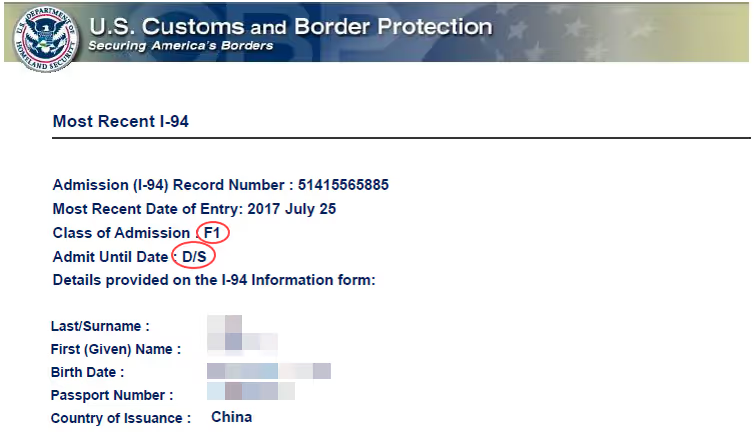

E
Employment Authorization Document (Form I-766/EAD)
A general term used to describe a card USCIS issues on Form I-766, Employment Authorization Card, to aliens who are authorized to work in the United States. The card contains a photograph of the individual and sometimes his or her fingerprint. An alien who has an EAD usually has open-market employment authorization, but there are exceptions.
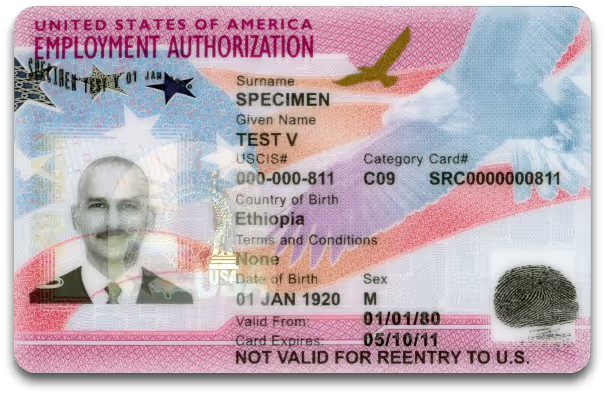
To learn more about EAD’s, see the following articles:
- Form I-765 EAD Step by Step Guide
- What is an EAD or OPT?
- Submitting an Expedite Request for the Employment Authorization Document (EAD)
F
F-1 Nonimmigrant Student
A person who has been admitted to the United States as a full-time academic student at an accredited college, university, seminary, conservatory, academic high school, elementary school or other academic institution, or in a language training program. The student must be enrolled in a program or course of study that culminates in a degree, diploma or certificate, and the school must be authorized by the U.S. government to accept international students.
To learn more about F1 Visas, see the following Articles:
- F1 Student Visa
- How Do I Apply For an F1 Visa?
- Can I change my F1 status to another non-immigrant status?
- What documents do I need in order to apply for an F1 visa?
- How long can I stay in the U.S. on an F1 visa?
- Can I work while in the United States on an F1 Visa?
- What are my employment options as an F1 Visa holder?
- Can I travel abroad while I am in the United States on F1 status?
Field office
Field offices are offices within a USCIS district that provide services and enforcement functions for a particular portion of the district.
Please note that applicants are assigned a specific field office depending on their physical address. USCIS does not allow for people to request specific field offices.
Use this link to find the field office nearest to you.
G
Green Card
A green card is also known as a Permanent Resident Card, Form I-551, or alien registration card. USCIS issues Green Cards to aliens as evidence of their lawful permanent resident status in the United States. For Form I-9, it is acceptable as proof of identity and employment authorization. Although some Green Cards do not have an expiration date, most are valid for 10 years. Cards issued to individuals with conditional permanent resident status are valid for two years.
To find out if you are eligible to apply for a Green Card, you can use our Eligibility Quiz Here.
I
Immediate Relative
USCIS offers specific protections or exemptions for the immediate relatives of US Citizens. Immediate relatives refer to the nature of the relationship between the petitioner and the beneficiary and includes the following relationship types:
- The spouses of U.S. citizens,
- The children (unmarried and under 21 years of age) of U.S. citizens,
- The parents of U.S. citizens at least 21 years old, and
- Widows or widowers of U.S. citizens if the U.S. citizen filed a petition before his or her death or if the widow(er) files a petition within 2 years of the citizen’s death.
Any other relationship type would not be considered to be an immediate relation. Examples of these other relationships include, but are not limited to, the following examples:
- The aunts or uncles of U.S. Citizens
- The Cousins of U.S. Citizens
- The siblings of U.S. Citizens
L
Last name
Family name or surname.
Lawful Permanent Resident (LPR)
Any person not a citizen of the United States who is living in the U.S. under legally recognized and lawfully recorded permanent residence as an immigrant. Also known as “permanent resident alien,” “resident alien permit holder,” and “Green Card holder.”
M
Maiden name
A woman’s last name or family name at birth, before she married.
Mailing Address
The address where you would like to receive written correspondence from USCIS.
N
Naturalization
Naturalization is the manner in which a person not born in the United States voluntarily becomes a U.S. citizen.
To learn more about Naturalization and the N-400, see the following articles:
- How to Become a United States Citizen
- Applying for U.S. Citizenship: 10 Most Common Questions
- What Happens After Submitting Your Form N-400?
- 4 Common Reasons Citizenship Applications are Denied
- How to Apply for Citizenship while Serving in the United States Military
- What is “Good Moral Character?”
To find out if you are eligible to apply for Citizenship, use our Eligibility Quiz here.
P
Permanent resident
See Lawful Permanent Resident.
Permanent Resident Card (Form I-551)
Also known as a Green Card or alien registration card, this card is issued by USCIS to aliens as evidence of their lawful permanent resident status in the United States. For Form I-9, it is acceptable as proof of identity and employment authorization. Although some Permanent Resident Cards contain no expiration date, most are valid for 10 years. Cards held by individuals with conditional permanent resident status are valid for two years.
Petitioner
A petitioner is a person who files an immigration petition or application on behalf of the beneficiary/intending immigrant.
For example, if a US citizen spouse is trying to get their spouse a green card, the US citizen spouse would be the petitioner and their spouse would be the beneficiary.
Processing Times
Processing times are an estimate of how long it will take to process your case from start to finish. Each case is different, so some cases may take longer than others to process. These processing times tend to be form- and location-specific. You can find our average processing times on the USCIS website. If you use your receipt number to check your case status, please remember that USCIS will only research your case if it is beyond their current processing times.
To look up the current processing times for your assigned field office, go to the following webpage.
R
Re-entry Permit
Permanent or conditional residents should apply for a re-entry permit if they will be outside the United States for one year or more. A valid re-entry permit allows you to apply for admission to the U.S. without having to get a returning resident visa from a U.S. Embassy or Consulate.
Receipt Number
The receipt number is a unique 13-character identifier that USCIS provides for each application or petition it receives. The agency uses it to identify and track its cases.
The receipt number consists of three letters-for example, EAC, WAC, LIN, SRC, NBC, MSC or IOE-and 10 numbers. You can find it on I-797 notices of action (also known as receipt notices) USCIS has sent you via the mail or digitally to your USCIS account.
Request for Evidence (RFE)
USCIS may send you a request for additional evidence if:
- You did not submit all the required evidence;
- The evidence you submitted is no longer valid; or
- The officer needs more information to determine your eligibility.
This request is placed by sending the applicant or petitioner a letter detailing what is being requested and when it needs to be submitted by.
S
Service centers
Service centers only adjudicate applications that individuals have mailed, filed electronically, or filed with a USCIS Lockbox. Service centers do not provide in-person services, conduct interviews, or receive walk-in applications or questions. USCIS has five service centers: California, Nebraska, Potomac, Texas, and Vermont.
Sponsor
In the immigration field, the term “sponsor” often means to bring to the United States or “petition for.”
Another meaning of the term “sponsor” is a person who completes Form I-864, Affidavit of Support Under Section 213A of the Act. However, this type of sponsorship is not the first step in any immigration process.
U
U.S. Citizenship and Immigration Services (USCIS)
USCIS is a federal agency in the Department of Homeland Security that oversees lawful immigration to the United States. Its functions include:
- Granting employment authorization to eligible aliens;
- Issuing documentation of alien employment authorization;
- Maintaining Forms I-9; and
- Administering the E-Verify employment eligibility verification program.
USCIS Number
A USCIS Number is a unique, 9-digit number assigned to a noncitizen by the Department of Homeland Security that is listed on the front of Permanent Resident Cards (Form I-551) issued after May 10, 2010. See also Alien Number.
USCIS Online Account Number
Your USCIS Online Account Number (OAN) is a unique identification number issued by the USCIS online filing system account. You should have one account number for all cases submitted.
Understanding the K-1 Letters of Intent to Marry
Applying for a K-I Visa can be stressful, but we are here to help.
What is a Letter of Intent to Marry?
A Letter of Intent (LOI) to Marry is one of the documents USCIS requires as part of the K-1 visa application. It is a letter that helps USCIS verify the relationship. In a Letter of Intent to Marry, the petitioner (the U.S. citizen) and the beneficiary (the applicant/intending immigrant) declare their intention and legal ability to marry within 90 days of the applicant’s arrival into the United States.
Attention! USCIS requires that both the petitioner and the beneficiary each write and sign their own LOI to Marry, which means that two letters of intent should be submitted in total.
What should be included in a Letter of Intent to Marry?
Depending on the specifics of the couple's situation, a Letter of Intent to Marry may include the following:
- A statement of the intent and legal ability to marry
- Both the petitioner and the beneficiary’s names
- A signature and date at the bottom of the letter
- Supporting evidence of wedding plans
What does a Letter of Intent to Marry look like?
The formatting of a Letter of Intent to Marry can vary, but a basic template can be used to ensure all necessary information is included.
Below are templates as well as examples of what a basic LOI to Marry can look like. Please remember that the petitioner and the beneficiary should each write their own letter, and that letters should be unique in content and writing style, even though both letters can follow the format shown below.
Templates & Examples
Template - Petitioner
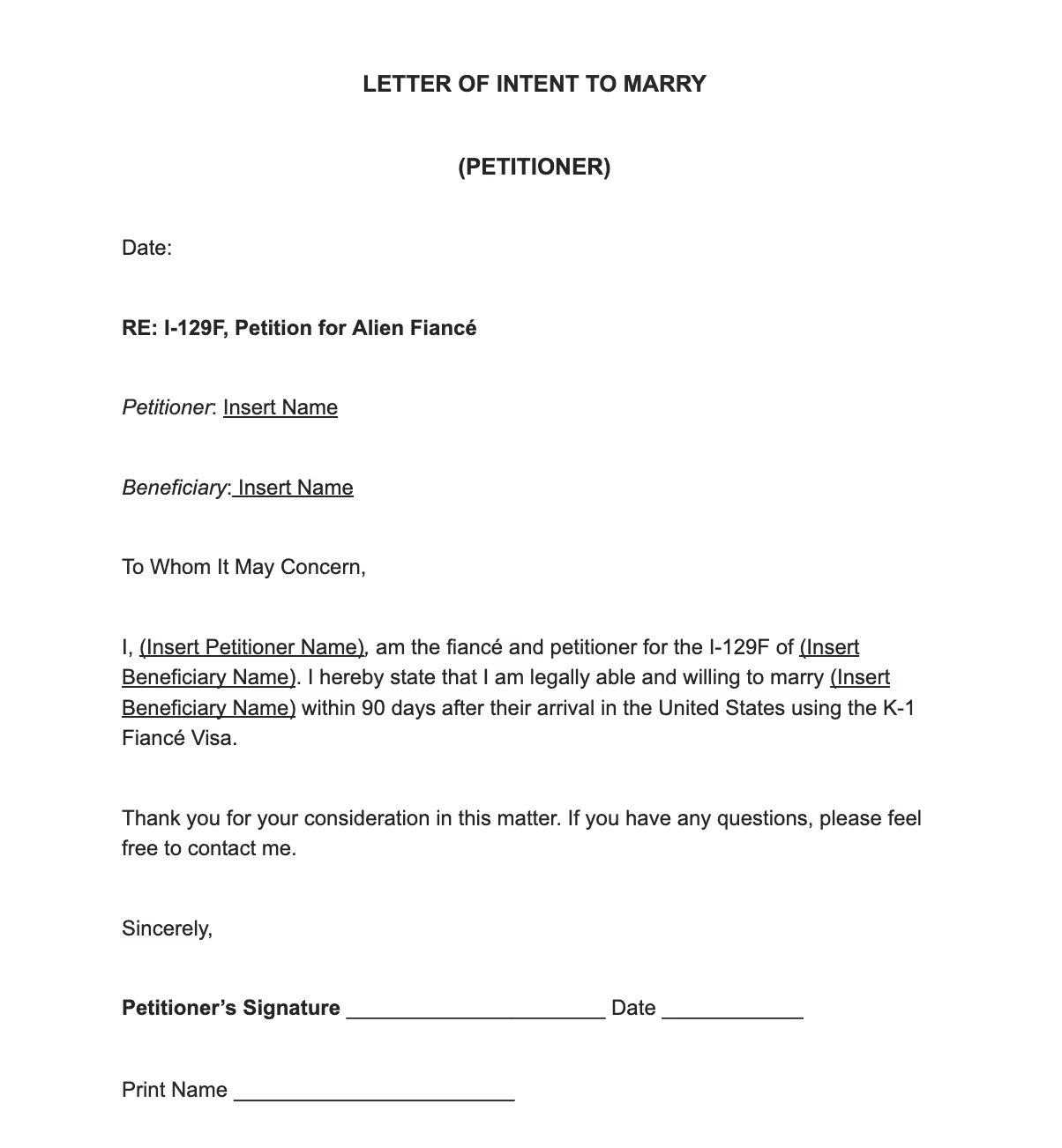
Example- Petitioner
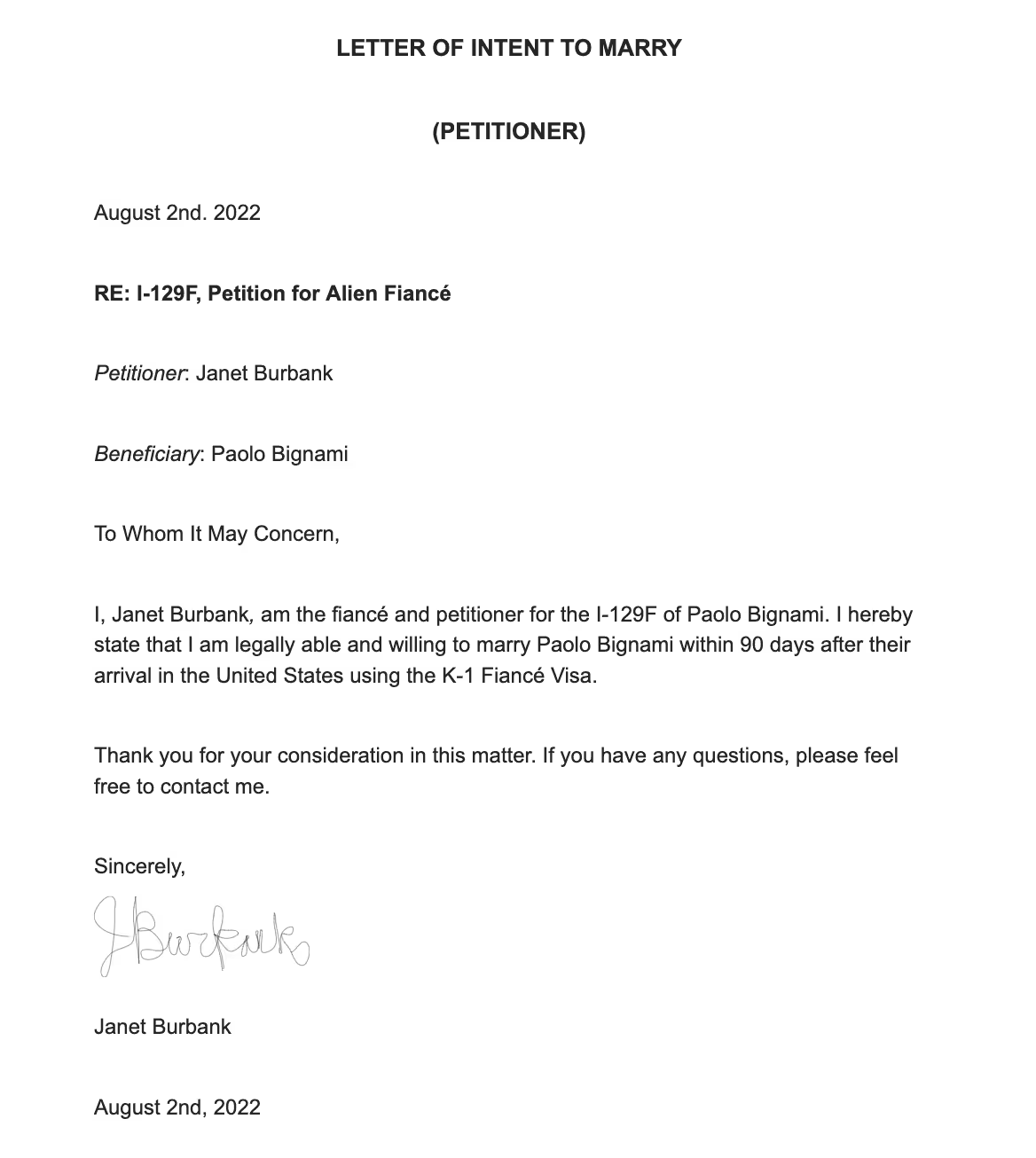
Template- Beneficiary
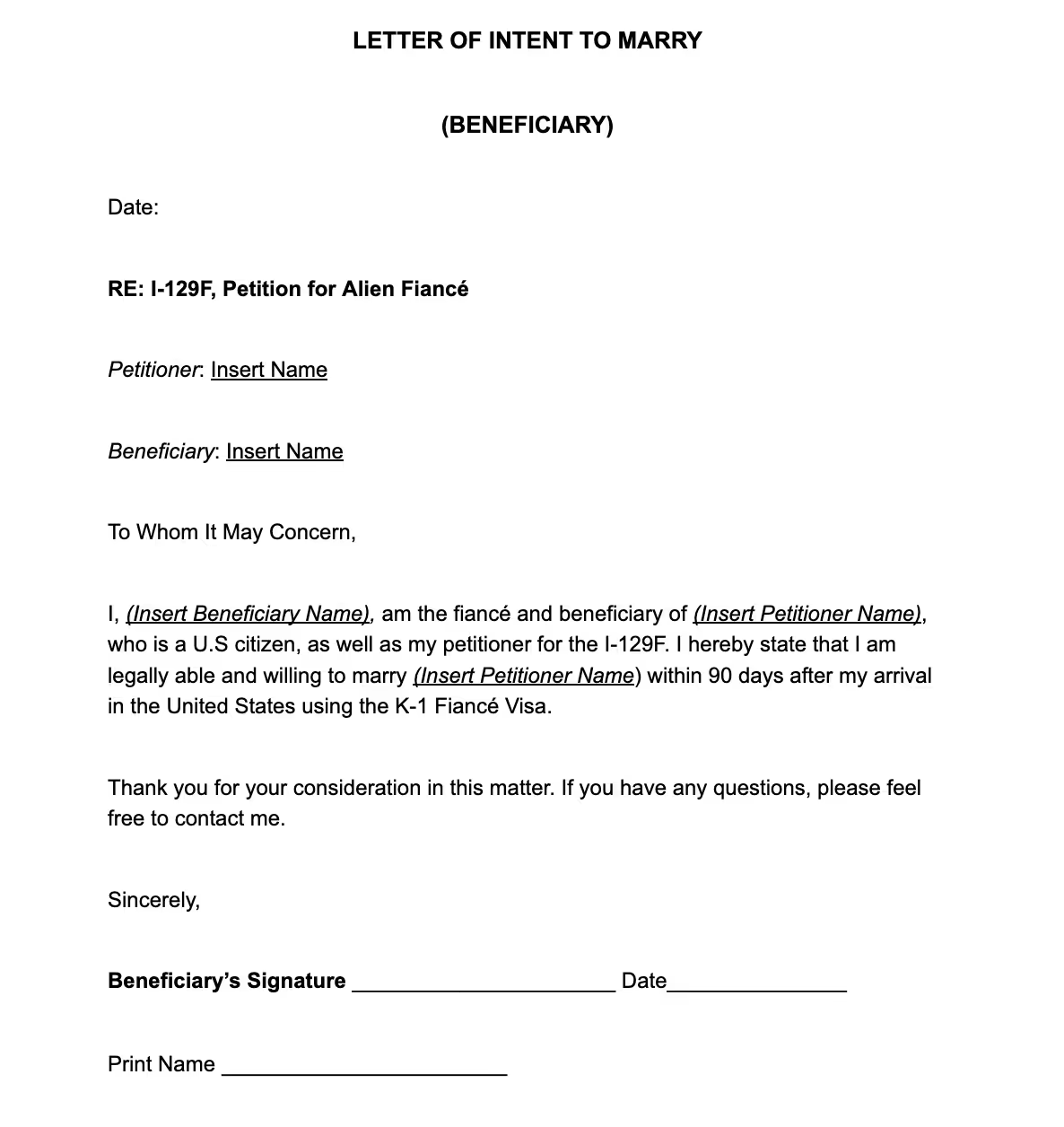
Example- Beneficiary
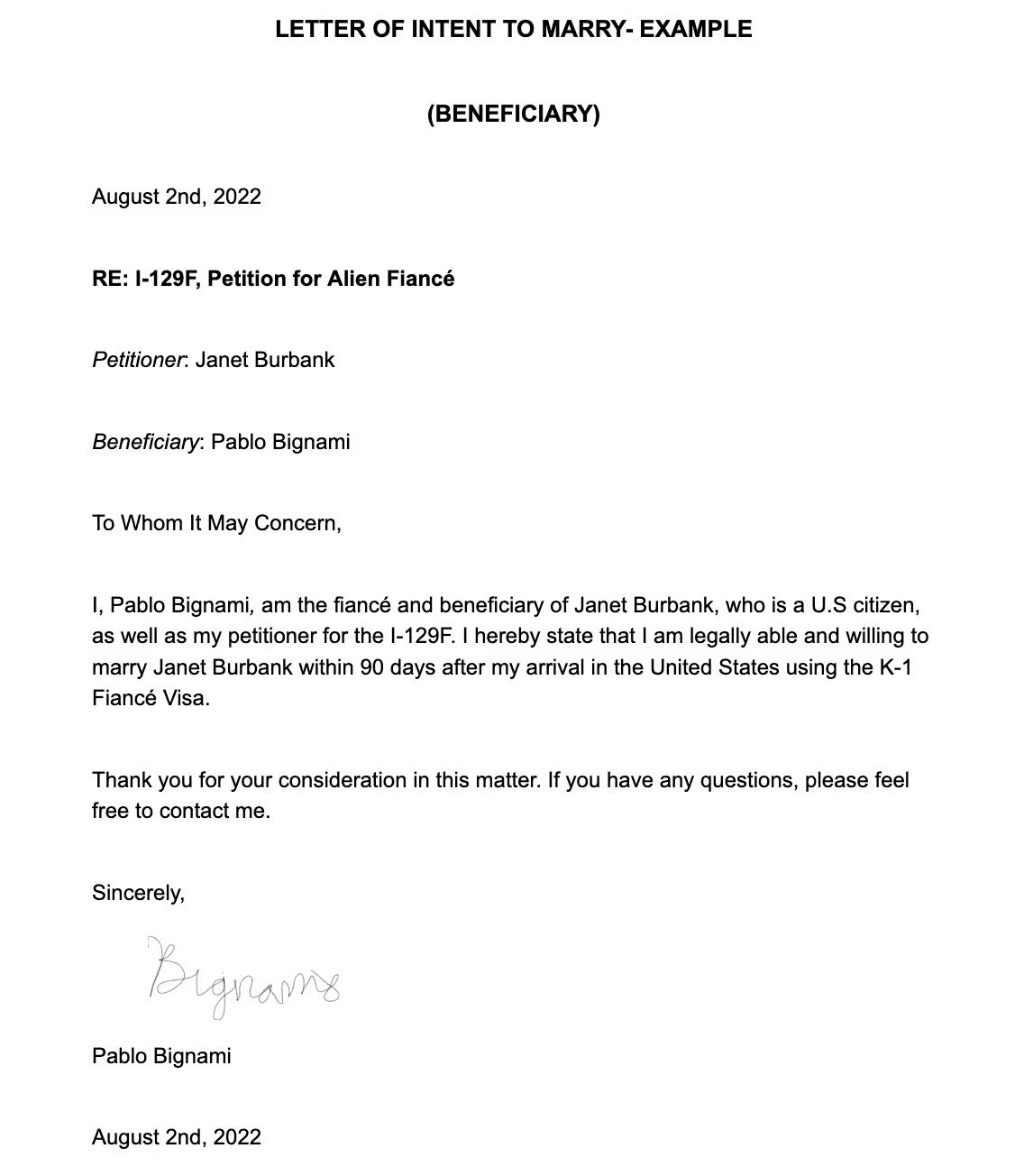
FAQs
Who needs to write a Letter of Intent to Marry?
The petitioner and beneficiary are each required to write their own Letter of Intent to Marry.
Is evidence required? What can I use as evidence?
Including supporting evidence with the K-1 visa application is required. However, USCIS does not have specific requirements for what must be included.
Evidence can include:
- reservation receipts for venue or catering,
- engagement photos,
- ring receipts,
- engagement announcements,
- text messages showing proof of wedding plans,
- communication with friends and family about the wedding,
- social media posts.
What if I don't know when the marriage will take place since it is dependent on the visa approval?
In cases where the marriage is dependent on visa approval, include as much information as possible about plans to marry. Although a specific date may not be set yet, general proof of the wedding taking place can be added.
This can include information about the couple’s relationship, timeline, and story, as well as proof of conversations about the couple’s upcoming marriage and that friends and family were made aware. Including evidence can be a good way of supporting the validity of the relationship.
Need help applying for a K-1 visa?
Applying for a K-I Visa can be stressful, but we are here to help. With packages including online support and reviews with our independent licensed partner immigration attorneys , all with a 100% money back guarantee, we have you covered. Click here to learn about our K-I visa packages.
We’re happy you’re here!
Understanding USCIS’ Race and Ethnicity Questions
Explore the definitions of race and ethnicity, how USCIS defines them, and how customers use them.
On many applications USCIS requires people to declare both their race and their ethnicity. In this article, we are going to explore the definitions of race and ethnicity, how USCIS defines them, and examples of how some people have chosen to interpret and respond to these questions in the past.
What is the difference between race and ethnicity?
Race is a concept that usually refers to the phenotypical (physical) characteristics of a person and it can be self-identified or not. On the other hand, ethnicity takes into account the cultural components of a person’s upbringing, and it doesn’t typically refer to physical characteristics of that person. For example: Two people that both identify as Hispanic as their ethnicity may choose differently for their race, one White, another Black, or a mix of both.
How does USCIS define the different options?
On their applications USCIS usually has 2 questions about Race and Ethnicity:
- The first one that asks for a person’s ethnicity: The question simply asks if you consider yourself Hispanic or Latino OR Not Hispanic or Latino
- The second one asks for a person’s race and you can answer by marking one or more boxes. The options are: White, Asian, Black or African American, American Indian or Alaska Native, Native Hawaiian or Other Pacific Islander.
Here is the definition of the different race options directly from USCIS instructions:
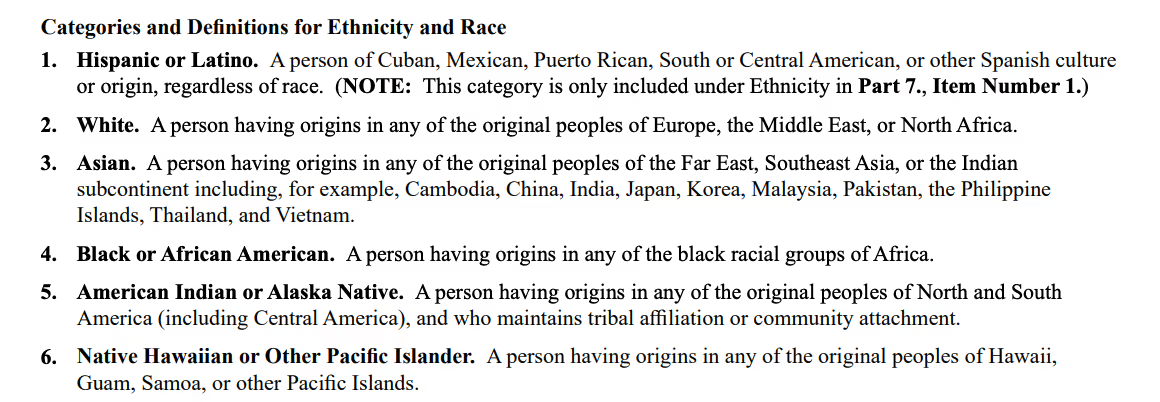
"When choosing between the race options, please make sure to carefully read through the USCIS definition of each of the options first.”
How should I answer if I am Hispanic/Latina/e/o/x?
Because USCIS considers Hispanic or Latino to be an ethnicity instead of a race, many people that choose the option “Hispanic or Latino” have different responses in the race question. Due to the multi-racial category that is Hispanic/Latina/e/o/x, many people choose between the options of White, Black, American Indian (if they have maintained tribal affiliation or community attachment as USCIS instructions show) or choose to mark more than one box.
How should I answer if I identify with more than one race/I Identify as biracial or multiracial?
The race question asks to mark *all applicable boxes*, so if you are a multi-racial person you can choose to mark all the boxes that apply to you.
Conclusion:
Please take into account that there isn’t a wrong or right answer for these questions. However, understanding USCIS definitions for race and ethnicity as well as a more clear understanding of how they define the various options within those questions, will hopefully help you answer this question more confidently and accurately.
Employment Verification Letter (EVL) 
Learn what an Employment Verification Letter is, why it's important and what it should include
What is the purpose of an employment verification letter?
When going through the immigration process, it is crucial to prove that the sponsor, and when applicable, the joint sponsor, meet the necessary financial requirements for their household size. In addition, USCIS will want to see proof of their current employment status. Both of these things are accomplished, in part, through an employment verification letter (EVL) that is submitted as evidence along with Form I-864. The employment verification letter provides evidence of both current employment and income.
Please note that an employment verification letter is different from an offer letter. An offer letter proves that employment was offered and an employment verification letter proves that employment is ongoing.
The employment verification letter is needed in addition to tax returns, pay stubs, and other financial documents. It is meant to strengthen the case by supporting the sponsor’s claim that they are able to provide adequate financial support to the applicant.
Who needs an employment verification letter?
The sponsor and, when applicable, any joint sponsor on a green card application will need to provide an employment verification letter. If the applicant is using their qualifying income to help meet the income requirements, they too will need to include an employment verification letter. The letter(s) will be required as evidence for Form I-864.
Creating an employment verification letter:
Who should issue an employment verification letter?
The employment verification letter should be issued by the company's HR department or the direct supervisor of the sponsor.
What type of paper should the letter be on?
The letter should be on official company letterhead.
What information should be included?
- The date that the employer is writing the letter. This should be within 2-3 months of submitting the application, ideally.
- The name, company address, and title of the person writing the letter.
- The employee’s position at the company.
- The date the employee started at the company.
- A description of the employee’s responsibilities.
- The annual salary (preferred) OR weekly rate and average weekly hours of the employee.
- The employee’s current status (part time/full time OR average hours worked per week).
- Wherever possible, a statement of prospective future employment (ie. a statement saying that the company anticipates you working there for an extended amount of time).
- Signature of the writer (HR representative or direct supervisor).
Example of an employment verification letter:
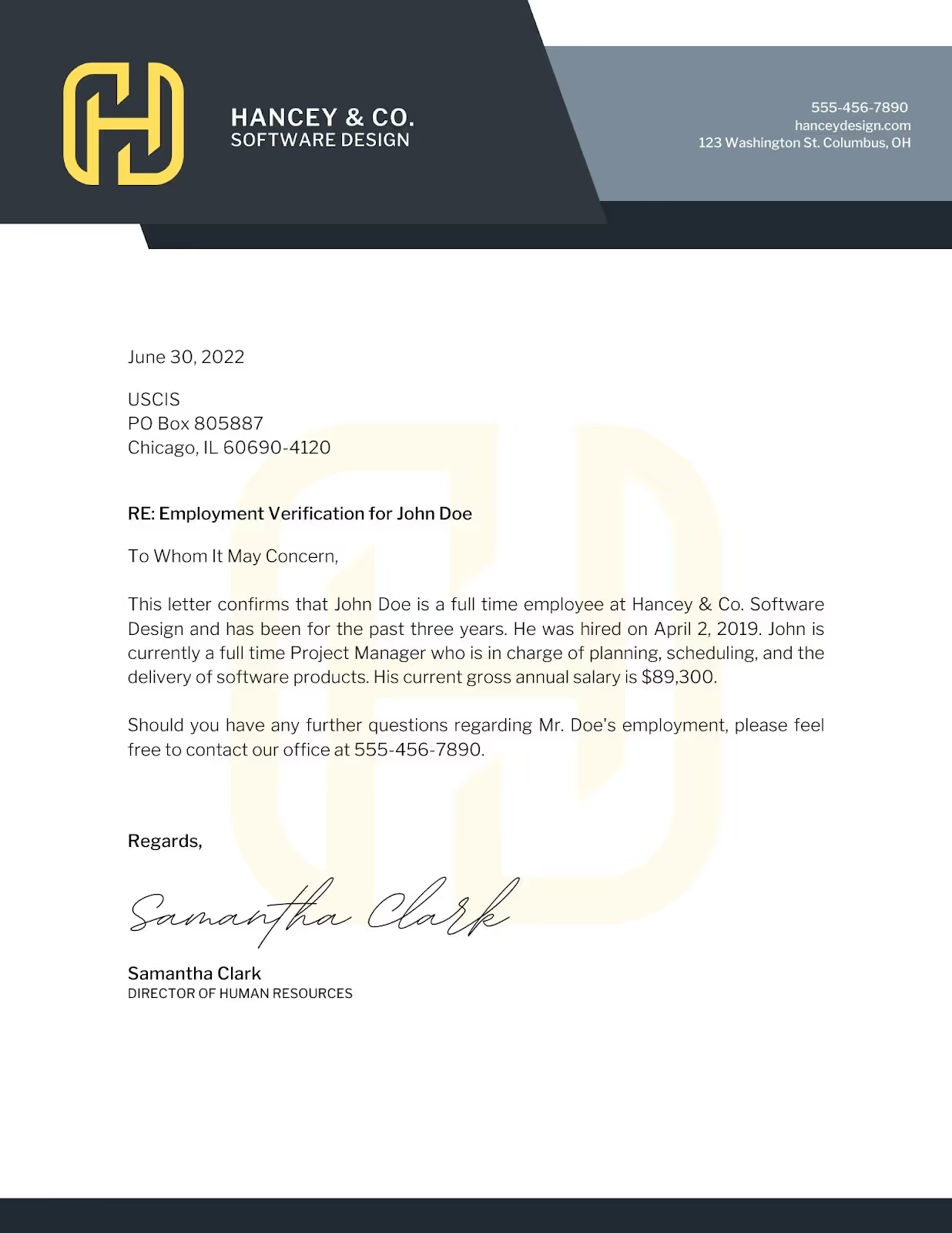
Employment verification letter template:
If you need some help getting started, click here to download a copy of our employment verification letter template.
FAQs:
What if I am self-employed?
When going through the Simple Citizen process, the system will let you select that you are self-employed. It will then ask you a series of questions about your income, job description, and dates of self-employment. The answers to these questions will replace the need for an employment verification letter with a list of new required documents.
What if I have more than one job?
If you have more than one job, you will need to include an employment verification letter for each job that you are currently employed at. You will then add the combined income values on all forms as the total annual income in the questionnaire.
I just started my job – do I still need an employment verification letter?
If you just started your job, adding the original offer letter as well as an employment verification would be the best way to illustrate your current employment to USCIS. USCIS is less likely to accept a sponsor’s documentation as sufficient if they started the job recently. Adding an Employment Verification letter with a statement of prospect of future employment (ie. a statement saying that the company anticipates you working there for an extended amount of time) can help improve your odds.
I have an employment verification letter from 5 months ago. Can I just submit with that one?
Since the overall goal of the employment verification letter is to prove that you are currently employed, you want to make sure the letter is as current as possible. As a best practice, your letter should be dated no more than 2-3 months before your application submission date.
What if I am paid hourly?
If you are paid hourly, you will want to have the author of the letter add your hourly rate and average hours worked each week. If your employer does not include an estimate of your annual income in the letter, best practice would be to also upload a signed conversion letter showing the math used to calculate your annual income.
How to calculate annual income:
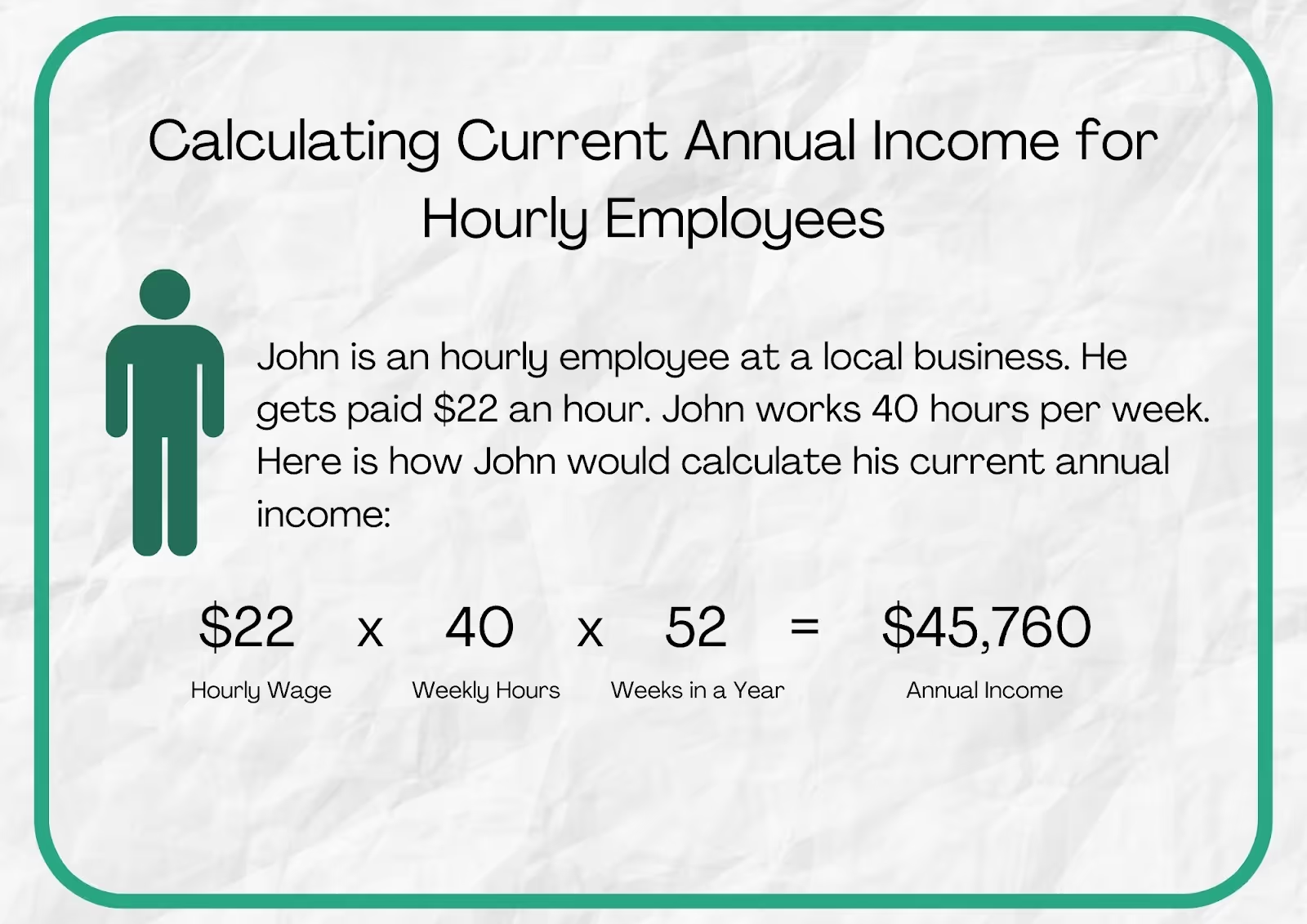
Conversion Letter Outline:
“Date
Dear USCIS officer, as shown on the employment verification letter, my hourly pay is _X_ dollars an hour and I work an average of _X_ hours each week.
[hourly pay] x [avg weekly hours] x [52 weeks/year] = a calculated estimated annual salary of _X_.
Name
Signature”
Conversion Letter Sample:
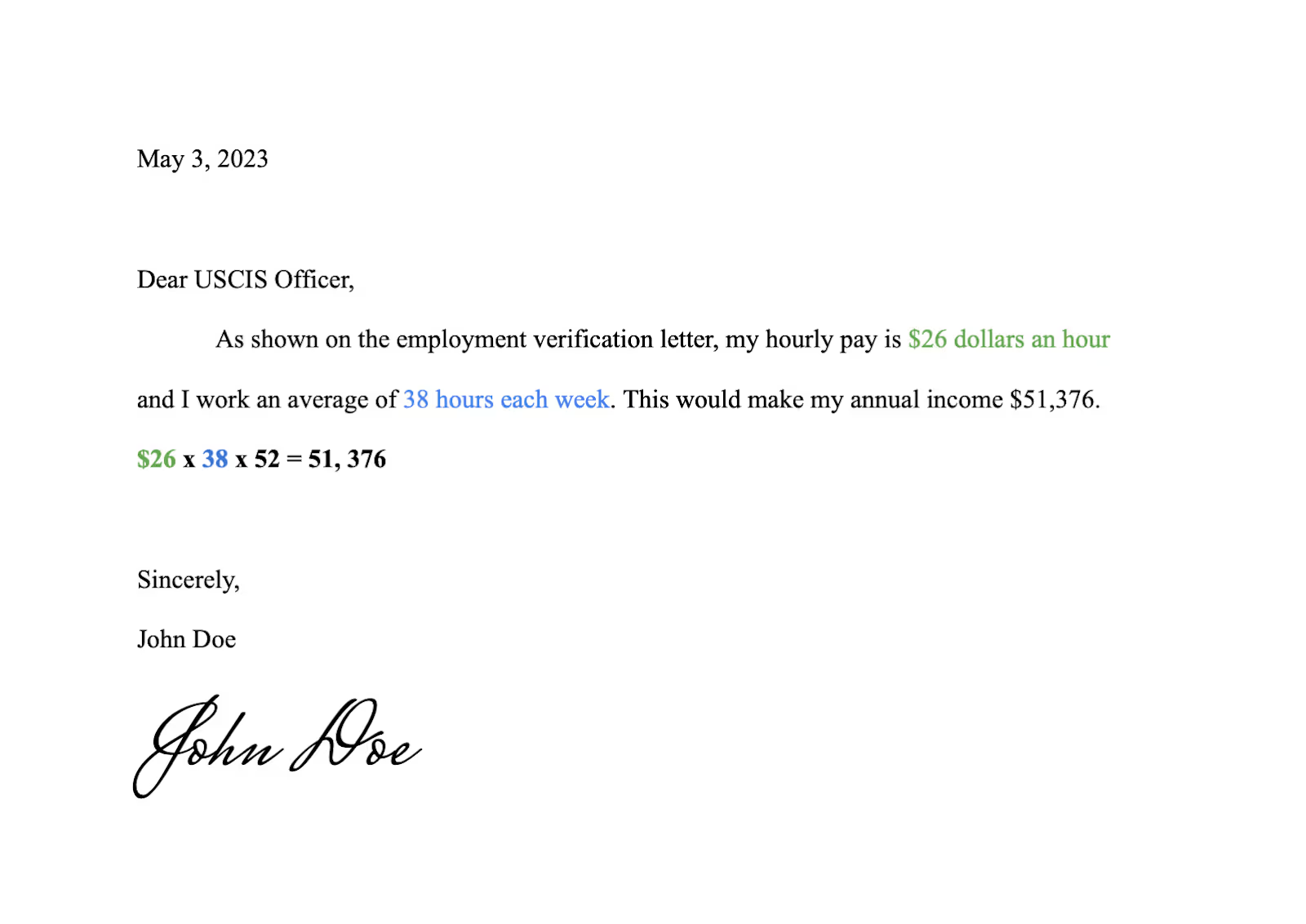
Calculating Current Annual Income for a Sponsor or Joint Sponsor
Understanding current annual income, why it's needed, and how to calculate it.
What is the current annual income and why is it needed?
The current annual income is the projected amount that a sponsor, and when applicable, joint sponsor, will earn that calendar year. Current annual income is calculated before any tax or other deductions and is sometimes referred to as gross income. Tax documents are not used to find the figure for current annual income as they are from a previous year and may not reflect financial changes. The current annual income helps support the claim to USCIS that the sponsor, and when applicable, joint sponsor, meet the financial requirements. The reported current annual income should match the salary figure listed on the employment verification letter (EVL).
Calculating current annual income
Salaried employees:
The current annual income will be your total annual salary. This should be stated on your employment verification letter and reflect on your pay stubs. Please note that bonuses or commission should not be included in this figure because they may not always be consistent.
Hourly employees:
Hourly employees will need to calculate their annual income by multiplying their hourly wage by the average number of hours they work each week. Then, multiply that number by the total number of weeks in a year (52).
Example:

FAQ:
What if I have more than one job?
Sponsors that have more than one job should calculate the current annual income for each job individually and then add them together. The total amount is what the sponsor will enter as their annual income. Please note that you will need to provide an Employment Verification Letter and 6 months of paystubs for each job referenced.
What if I am self-employed?
If the individual is self-employed and does not work consistent weekly hours, they can estimate their income by calculating their monthly average using their net individual (not business) income for the year so far divided by the number of months in the year that have passed multiplied by months.
Example:
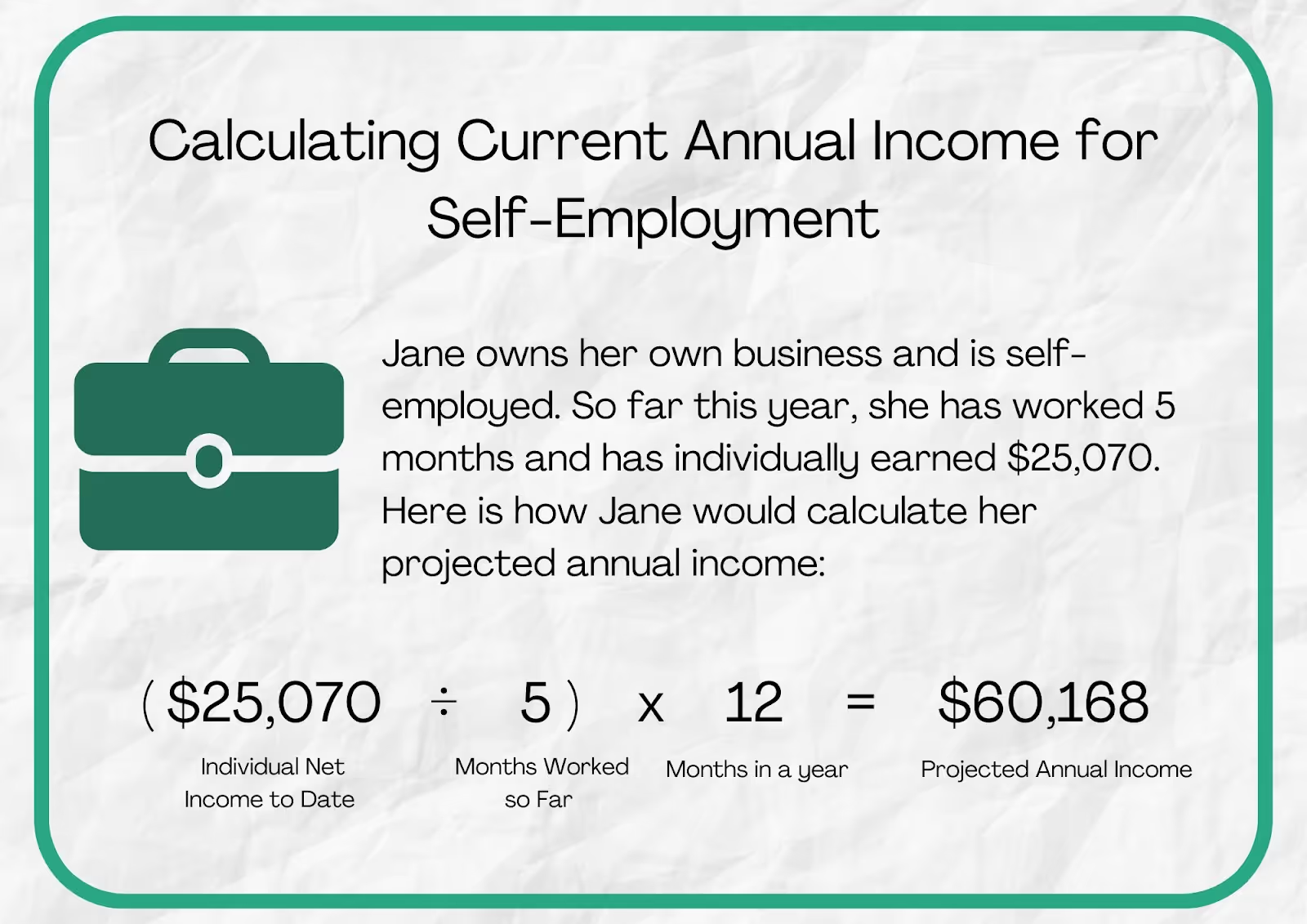
My employer only included my hourly wages on my employment verification letter, but not my annual salary. What should I do?
If possible, it is best for your employer to include your annual salary in your employment verification letter. If you are paid hourly, you will want to ask that they include your hourly pay rate and your average hours worked each week. Be sure to add a separate conversion letter that contains the following conversion equation to show USCIS how you calculated your annual income.
Conversion Letter Sample

What is the difference between annual income and total income?
Annual income is the raw income that someone makes before any kind of deductions. Total income (reflected on the 1040 Tax Return and W-2 Form) is the net income that is calculated after all withholdings are accounted for. Please note that when listing your previous tax income history, you will use the total income amount from each tax return. However, for the current annual income, you will want to list your annual income, not your total income.
Letters of Support from Friends and Family
Letters of support are statements by friends and family that help support the validity of the marriage
Last Updated: January 15, 2020
What are letters of support and why do I need them?
In marriage-based green card cases, USCIS is looking for evidence of a bona fide marriage. A bona fide marriage is another way of saying a real marriage, entered into in good faith. It is important to prove to USCIS that your marriage is genuine since they are on the look out for fraudulent marriages. Essentially, they want to make sure that an applicant married the petitioner for love and not in pursuit of a marriage-based immigration benefit.
One type of evidence that USCIS allows you to include to help prove that your marriage is legitimate is Letters of Support. Letters of support are statements written by friends and family of the couple that help to demonstrate the validity of the marriage. While letters of support do not replace more concrete evidence such as joint assets or a shared address, they help build up the credibility of the marriage. For that reason, applicants can include some in the Relationship Evidence section of their application to further strengthen their application.
Who can write a letter of support?
A letter of support can be written by anyone who has known the couple from before marriage to present time. The writer should be familiar with the couple’s relationship. Examples of people who could write a letter of support include:
- Family members
- Friends
- Religious leaders
What should be included in letters of support?
The letter is the writer’s opportunity to explain their experiences with the couple. Each letter of support should be unique. However, there are things that each letter should contain, such as::
- Full name and address of the person writing the letter.
- Date that the letter is being written.
- Date and place of birth of the writer.
- The writer’s experience with the couple:
- How long the writer has known the couple.
- The nature of the relationship between the writer and the couple.
- How often the writer interacts with the couple.
- Descriptions of the interactions or activities between the writer and the couple.
- A written statement that says, “I swear, under penalty of perjury, that the foregoing is true and correct to the best of my knowledge.”
- A copy of the writer’s I.D. on a separate sheet of paper.
- The wet signature of the writer.
Examples:
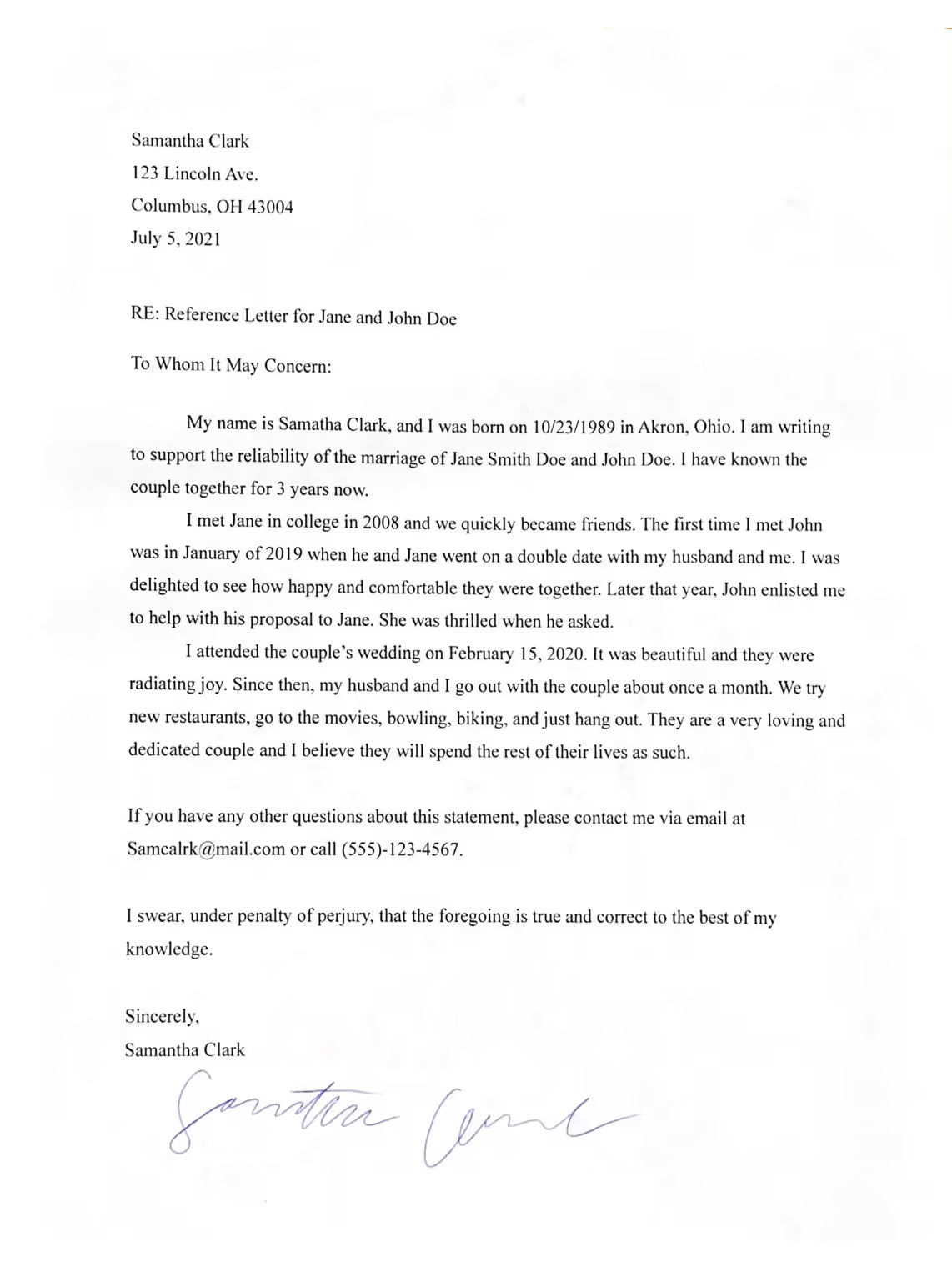
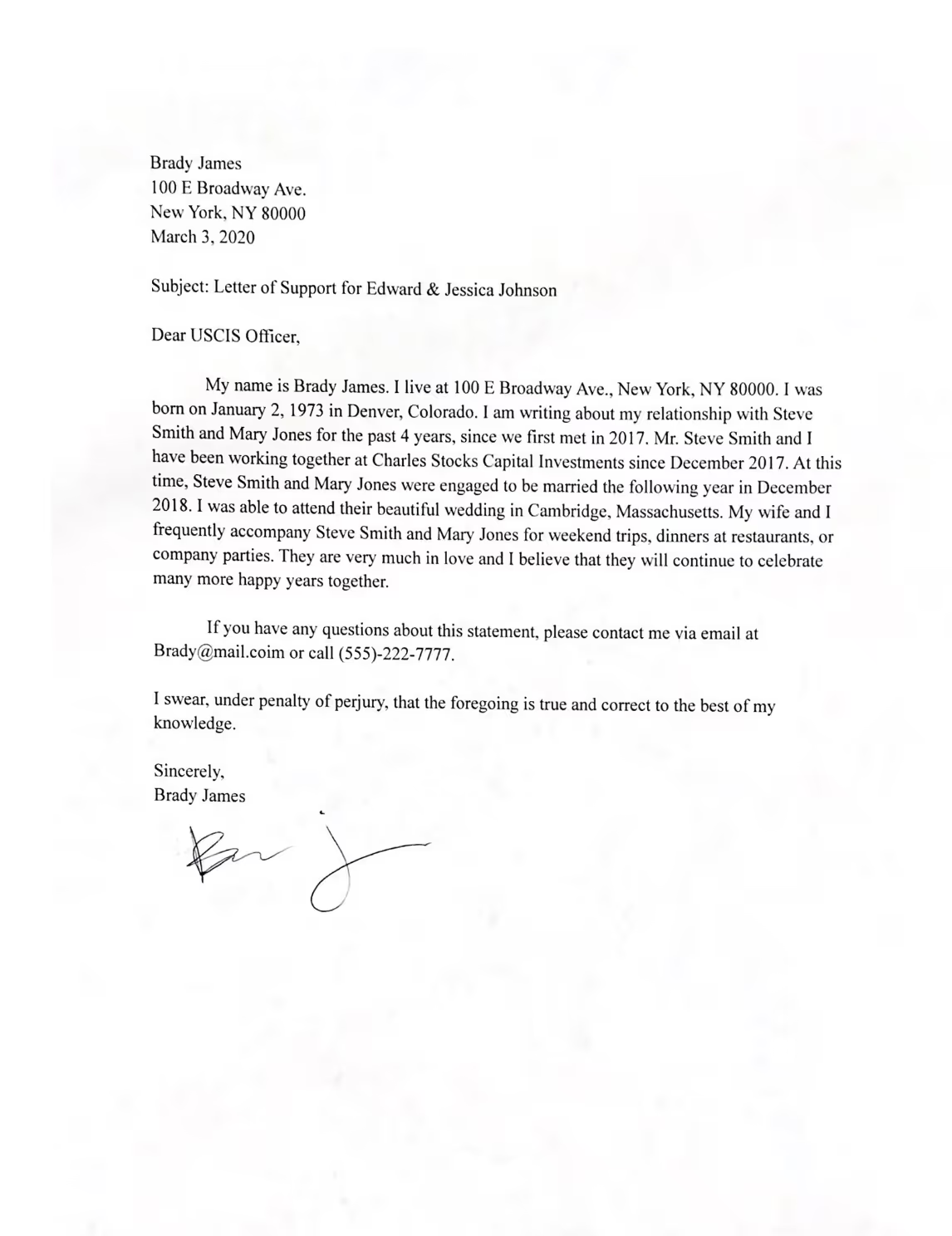
FAQs:
How many letters of support should be included?
Though USCIS has not officially stated how many letters of support should be included, our partner attorneys recommend that each case include around 3-5 letters of support. Each letter should be unique in both content and style of writing.
Do the letters need to be notarized?
The letters do not need to be notarized. However, it is helpful to include a statement that swears to the validity of the letter such as, “I swear, under penalty of perjury, that the foregoing is true and correct to the best of my knowledge.”
Does the writer need to be a citizen of the United States?
No, the writer does not have to be a U.S. citizen or even living in the United States.
Does the letter need to be translated into English?
If the letter is in a language other than English, you will need to include a translation of the letter into English along with the original letter. It does not need to be a certified translation, but the translator should include a signed, written personal statement that they are fluent in both languages and that the translation appropriately reflects the document. Here’s an example of what that could look like:
Translation Letter Sample:
Date
I (the translator’s full name), certify that I am fluent in English and have translated (list the specific documents here) from (language) into English as completely and accurately as possible. I’ve attached both the copy of the original document and the translation here.
Sincerely,
Full Name
Physical Mailing Address
Signature
Calculating Current Annual Income- Multiple Jobs in a Calendar Year
Calculating Current Annual Income- Multiple Jobs in a Calendar Year.
Last Updated: October 5, 2022.
When reviewing your annual income, USCIS will consider not just a sponsor’s current income, but also how long they have been with their current employer and how much they will make throughout the current year. Because of this, if a sponsor has had multiple employers during the current calendar year many people find the most success with USCIS when they report not just their current job’s income, but also their projected income for the calendar year based on both past and current jobs. This projected income should be as accurate as possible and should be supportable with evidence.
Note: When determining annual income, USCIS only considers an individual’s base salary. Overtime, bonuses, stipends, tips, commissions, or other irregular sources of income are not guaranteed to be paid and will not be considered by USCIS.
We know this can be complicated so we are here to help give you examples and guide you through the process.
How to calculate a sponsor’s projected annual income
To calculate their annual income the sponsor will list all jobs they have held throughout the current calendar year and determine what their year-to-date earnings were for each of their jobs. If they have multiple current jobs they can all be added in this list of jobs. Then, they will calculate how much they anticipate earning with their current job from their start date to the end of the year.
Let’s show an example to see what this could look like:
Sarah has had 3 different jobs during the current calendar year.
Job #1: Sarah was at this job from January - April: Her last pay stub showed a year to date income of $7,040.
Job #2: Sarah was at this job from June - August: Her last pay stub showed a year to date income of $5,600.
Job #3 (Current): Sarah started this job in September. She makes $15 an hour and works an average of 15 hours a week. From the time Sarah started her job to the end of the year there are 17 weeks in the year. Sarah can calculate her projected income at this job by multiplying her weekly average earnings ($15 x 15 hours = $225 weekly) by the 17 weeks she will work at this job in the year. This makes her project income $3,825.
To calculate annual income Sarah will then add those job positions together to calculate her current annual income.
$7,040 + $5,600 + $3,825 = $16,465
Sample Projection Letter
Here is a sample projection letter that can be used to clearly map out this income for USCIS so they can see how this income was calculated. At the bottom of this article there are links to PDF and a Docx versions of this template letter.
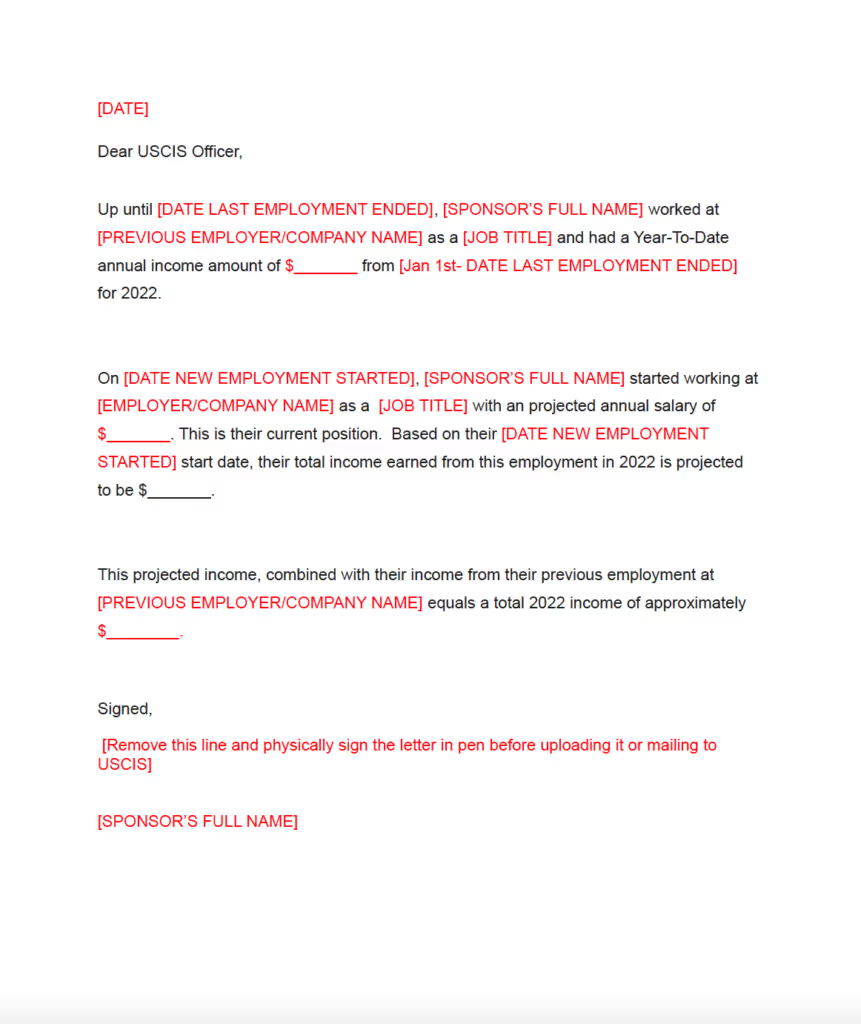
In addition to creating a letter that projects their income following the above sample, the sponsor can also add proof of income for all jobs added from the year.
Documentation
USCIS wants to see proof of the reported annual income. Here is what our partner attorneys recommend:
- Last 6 months of pay stubs. If the sponsor has changed jobs during that time it is recommended to add all pay stubs from that time period, even if from a previous employer.
- Final 2 pay stubs from any previous employers the sponsor has had in the calendar year. This is so USCIS can see their YTD earnings from those jobs and verify the annual income.
- Employer Letter from the sponsor's employer on company letterhead. It should state their title, start date, and annual salary. If they are paid hourly it is recommended that they report hourly rate, average weekly hours worked, and what that makes the sponsor's annual income. Many companies have automated processes for generating these letters. Often they can consult with their Human Resources Department to get that letter issued.
- If they have had multiple jobs, include a projected income statement following the template discussed above.
Interpreters at Your Interview
Understanding some of the basics for bringing an interpreter to USCIS interviews.
An applicant (also referred to as a "beneficiary") may not be fluent in English and may require the use of an interpreter at the adjustment interview.
At the adjustment interview, the interpreter should:
- Present their valid government-issued identity document
- Complete an interpreter’s oath and privacy release statement
- Translate what the officer and the applicant say word-for-word to the best of their ability without adding the interpreter’s own opinion, commentary, or answer
In general, a disinterested party should be used as the interpreter.
The USCIS officer conducting the interview may exercise discretion, however, to allow a friend or relative of the applicant to act as interpreter. If the officer is fluent in the applicant’s preferred language, the officer may conduct the examination in that language without use of an interpreter.
USCIS reserves the right to disqualify an interpreter provided by the applicant if the officer believes the integrity of the examination is compromised by the interpreter’s participation or the officer determines the interpreter is not competent to translate.
Perhaps it may be found within a different category.
